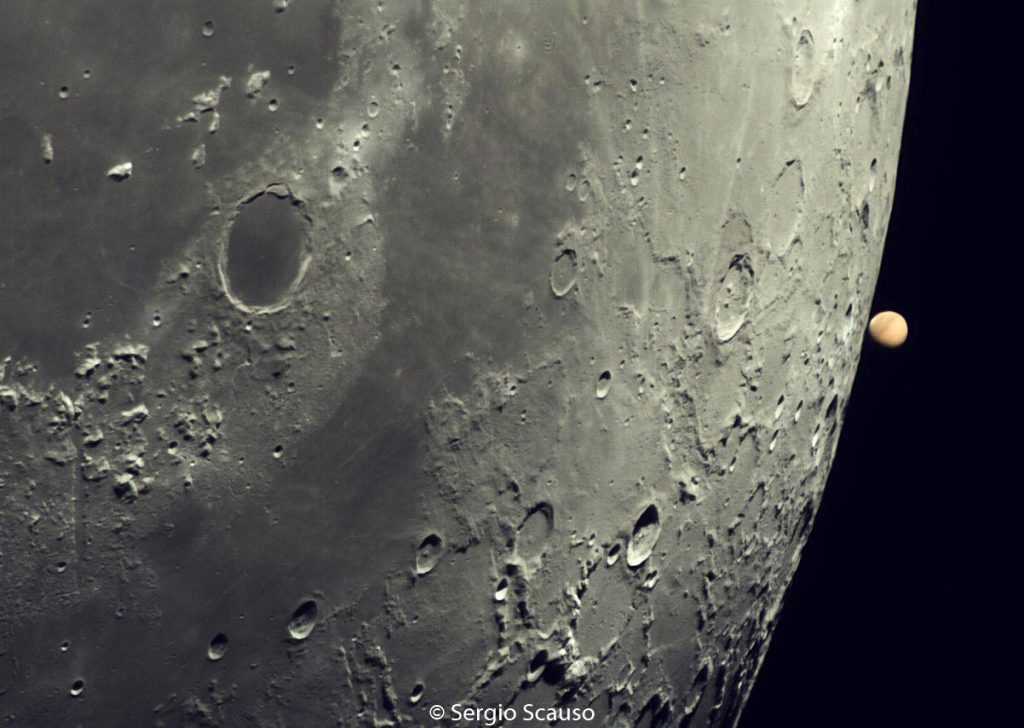

Ay ara sıra Mars da dahil olmak üzere güneş sistemindeki tüm gezegenlerin önünde hareket eder. Kredi bilgileri: Sergio Cuzzo
Aralık 2022’de gökyüzü izlemenin öne çıkan özelliklerinden bazıları nelerdir? Ay geçip gidiyor[{” attribute=””>Jupiter twice this month, and actually covers Mars completely, in an event called an occultation, on December 7. The event is visible across the U.S., except for the Southeast and East Coast, where the Moon will graze closely past Mars. And throughout the month, you can find Pegasus, the winged stallion, high overhead in the south.
Aralık 2022’de nelere dikkat edilmeli: Mars ortadan kayboluyor ve Pegasus bir maceraya atılıyor. Amerika Birleşik Devletleri ve Avrupa’nın çoğundan izleyiciler, 7 Aralık’ta Mars’ın ayın arkasına kaymasını izleyebilir ve herkes kanatlı at takımyıldızı Pegasus’u görebilir.
- 1 Aralık -Ay’ı parlak Jüpiter’den sadece birkaç parmak ötede bulmak için bu akşam güneybatıya bakın.
- 7 Aralık – Dolunay
- 7 Aralık Ay bu gece Mars’ı gölgede bırakıyor. Amerika Birleşik Devletleri’nde Mars, Doğu Kıyısı ve Güneydoğu’nun ötesindeki her yerdeki izleyiciler için ayın arkasına doğru kayıyor ve burada ay, Mars’ı zar zor geçiyormuş gibi görünecek. Mars’ın ne zaman kaybolacağını ve yeniden ortaya çıkacağını öğrenmek için en sevdiğiniz yıldız izleme uygulamasını veya web sitesini kontrol edin.
- 23 Aralık – yeni Ay
- 25-31 Aralık – Yıl sonunda ayı ve gezegenleri kontrol edin. Her akşam giderek artan dolunayın geçişini izleyin[{” attribute=””>Saturn on the 26th and then past Jupiter on the 28th.
- All month – Find the constellation Pegasus high in the south-southwest after dark. Look for bright Jupiter and find the Great Square of Pegasus about 15 degrees above it.

Lunar occultation of Mars. Credit: Andrés Jobacho
Video Transcript:
What’s Up for December? Your evening planet highlights, including the disappearance of Mars, and the constellation Pegasus.
The month begins and ends with the Moon visiting the giant planets. On December 1st, find the Moon just a couple of finger-widths apart from Jupiter in the evening sky. Then, from the 25th to the 31st, look to the southwest following sunset to see an increasingly full Moon slip past Saturn and then again past Jupiter. Viewers with a clear view to the horizon will be able to search for Venus and Mercury in the fading glow of sunset, just a few degrees above the skyline.
December 7 brings one of those magical moments when the sky changes dramatically before your very eyes. It’s called a lunar occultation, as the Moon passes in front of, or occults, the Red Planet, Mars. The spectacle will be visible in parts of North America, Europe, and Northern Africa. (Viewers in the Southeast and on the East Coast will see the Moon just graze past Mars.) For viewers in the U.S., Mars disappears behind the Moon sometime between about 6:30 and 9 p.m., depending on your location, so check your favorite skywatching app to find the time for your area.
Now, the Moon passes in front of planets in the night sky several times per year. In fact, it generally occults Mars itself at least a couple of times per year. But each occultation is visible from only a small portion of Earth’s surface, so it’s not super common for any particular spot on Earth to see them frequently.
Of course, the Moon passes in front of stars all the time. If you’re watching through binoculars, they just blink right out. But planets are not just points of light like stars – they appear as circular little disks, so planets actually take several seconds to disappear and later reemerge. So if you’re in the viewing zone, enjoy this relatively rare opportunity to watch a bright planet being occulted by the Moon.
Looking high in the southwest sky on December evenings, you can find a constellation named for one of the more fantastical beasts of ancient mythology. That’s Pegasus, the winged horse. In Greek myth, Pegasus rode into adventures with the hero Belaraphon, and later carried the thunderbolts of Zeus himself, who rewarded him by placing him among the stars.
Pegasus is one of the largest of the 88 constellations. Its most prominent feature, and the key to finding it in the sky, is this asterism, or pattern of stars, called the Great Square. These four stars of roughly equal brightness form the central part of the horse’s body.
This December, it’s easy to locate Pegasus, thanks to brilliant Jupiter. Face southward to find the giant planet about halfway up the sky, with the Great Square beginning about 15 degrees to the north of it.
Pegasus is a useful constellation for stargazers, as it’s a good starting place for finding your way to other features in the night sky. The constellation itself contains a number of dazzling deep-sky objects, including globular cluster M15, and the tangled galaxies of Stephan’s Quintet. With this year drawing to a close, here’s hoping you seek out the winged stallion Pegasus, as you ponder what new adventures await in the next year.
Here are the phases of the Moon for December.

The phases of the Moon for December 2022. Credit: NASA/JPL-Caltech
Stay up to date with all of NASA’s missions to explore the solar system and beyond at nasa.gov. I’m Preston Dyches from NASA’s Jet Propulsion Laboratory, and that’s What’s Up for this month.

“Analist. Tutkulu zombi gurusu. Twitter uygulayıcısı. İnternet fanatiği. Dost pastırma hayranı.”





More Stories
Bilim insanları dünyadaki en büyük demir cevheri yataklarında milyar yıllık bir sırrı keşfetti
Fosillere göre tarih öncesi deniz ineği, timsah ve köpekbalığı tarafından yenildi
Büyük bir bindirme fayı üzerine yapılan yeni araştırma, bir sonraki büyük depremin yakın olabileceğini gösteriyor